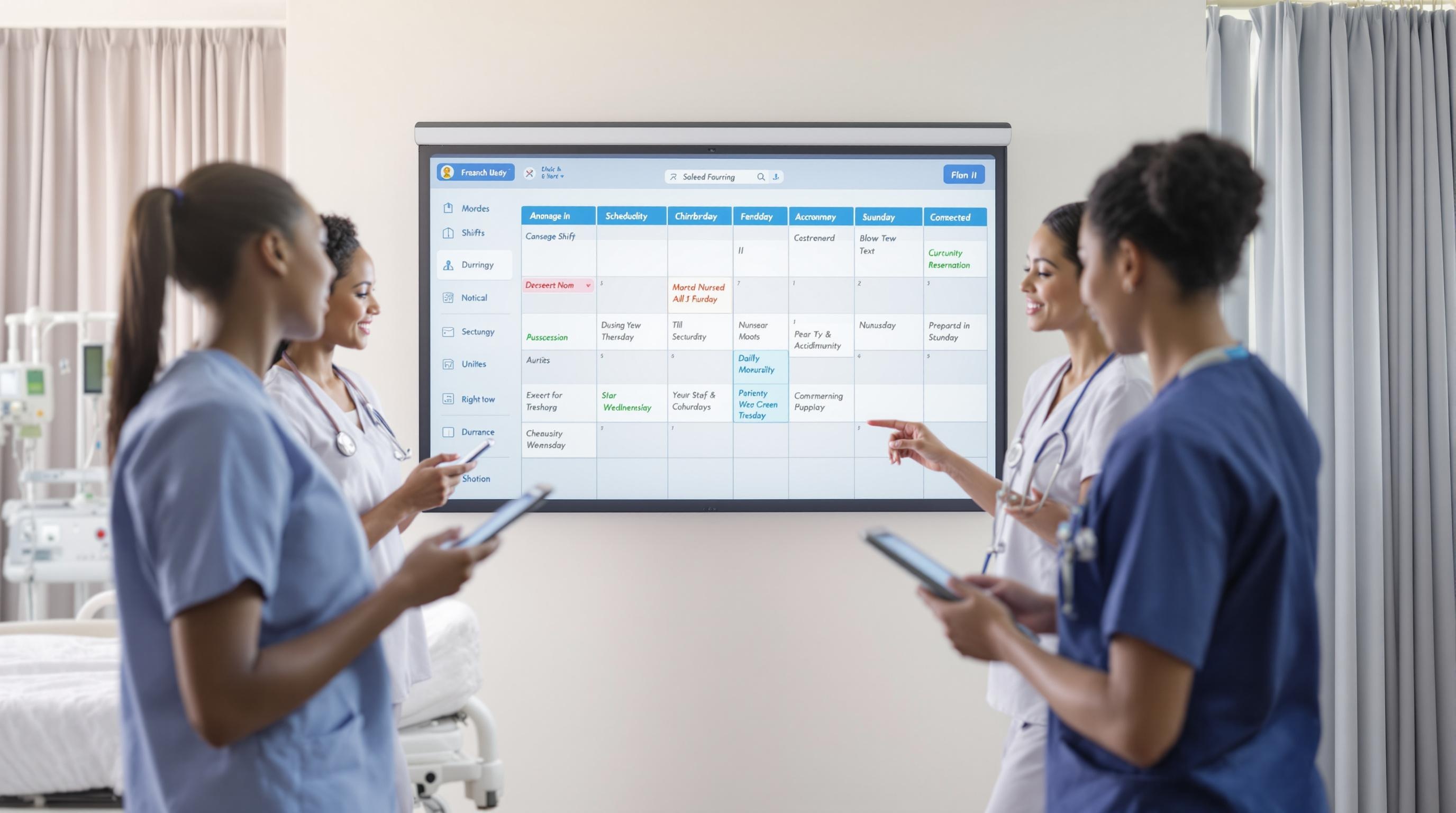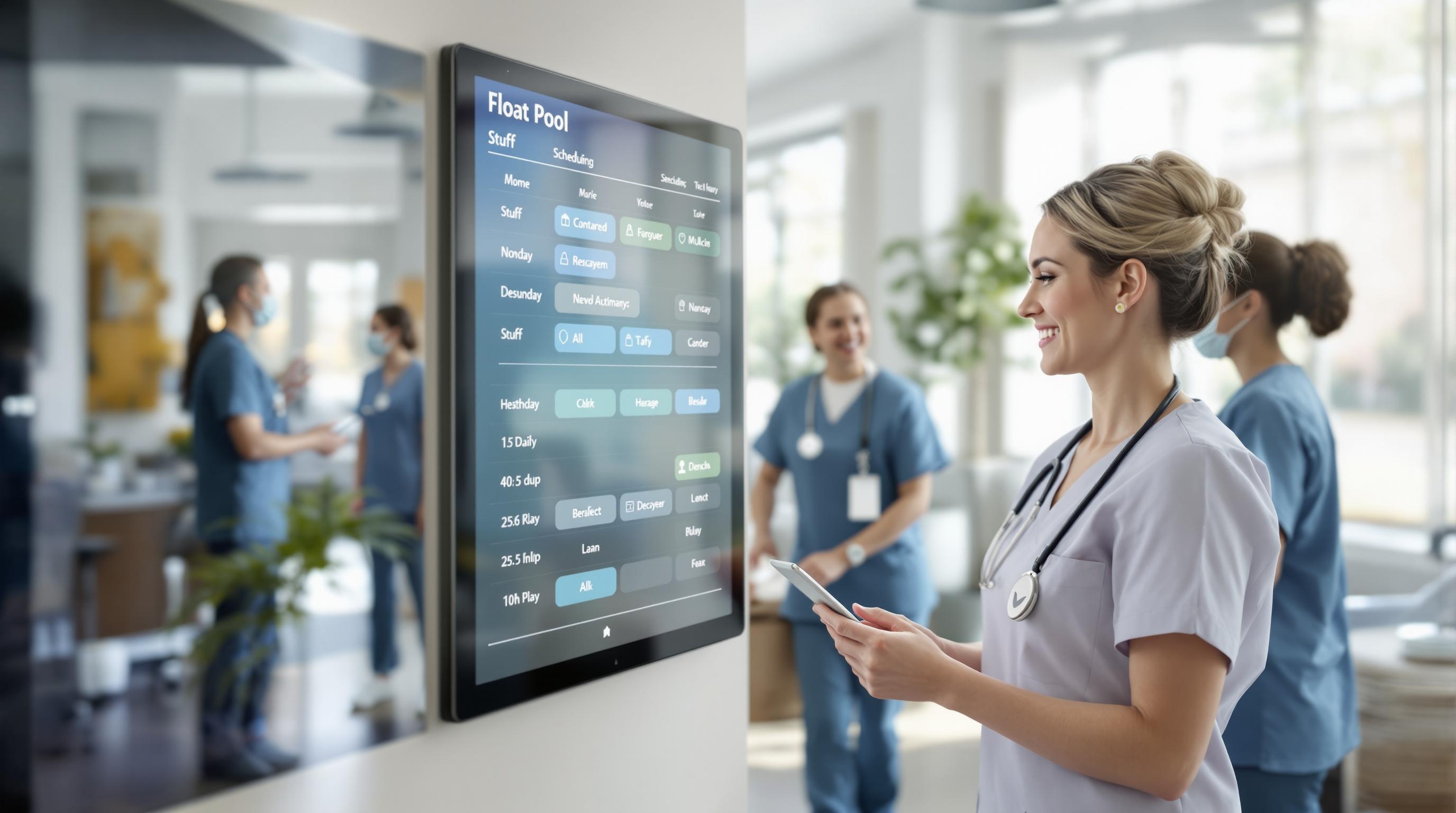Nursing Staff Management System: Optimize Skilled Nursing Care
Discover how a nursing staff management system improves efficiency, staffing, and patient care in skilled nursing facilities. Explore key benefits today.
Quick Navigation
- 1. Introduction
- 2. Current Challenges in Nursing Staff Management System
- 3. How Sparkco AI Transforms Nursing Staff Management System
- 4. Measurable Benefits and ROI
- 5. Implementation Best Practices
- 6. Real-World Examples
- 7. The Future of Nursing Staff Management System
- 8. Conclusion & Call to Action
1. Introduction
Did you know that the United States faces a projected shortage of over 1 million nurses by 2030? As this staffing crisis intensifies—fueled by an aging population, increasing patient acuity, and widespread nurse burnout—skilled nursing facilities (SNFs) are under unprecedented pressure to do more with less. According to recent reports, nurse leaders cite workforce shortages and rising demands as their top concerns in 2024, with staffing challenges directly affecting care quality and employee retention.
Traditional approaches to nurse scheduling and assignment are no longer sufficient in today’s fast-paced, technology-driven healthcare environment. Manual processes often result in inefficiencies, uneven workloads, and missed opportunities to support nurse wellbeing. At the same time, expectations for personalized, high-quality care are at an all-time high. This is where modern nursing staff management systems come into play—leveraging digital tools, automation, and even artificial intelligence to optimize staffing, boost nurse satisfaction, and enhance resident outcomes.
In this article, we’ll explore the evolving landscape of nursing staff management in skilled nursing facilities. You’ll discover how cutting-edge solutions, such as machine learning-driven assignments and workforce management software, can address staffing shortages, streamline operations, and empower nursing teams. We’ll also highlight the most impactful trends for 2024—and what SNF leaders need to know to stay ahead in a changing industry. Ready to reimagine workforce management in your facility? Let’s dive in.
2. Current Challenges in Nursing Staff Management System
Effectively managing nursing staff is a cornerstone of high-quality healthcare delivery, especially in skilled nursing facilities. However, many healthcare organizations encounter persistent challenges when it comes to their nursing staff management systems. These challenges impact daily operations, regulatory compliance, and—most importantly—patient care outcomes.
-
1. Staffing Shortages and Scheduling Complexity
One of the most significant issues is the ongoing shortage of qualified nursing staff. According to a study published in the Journal of Nursing Management, nurse managers report that high turnover rates and absenteeism complicate scheduling, often leaving shifts understaffed or overburdening existing staff. This not only strains employees but also increases the risk of burnout and medical errors. -
2. Inefficient Communication Channels
Many facilities still rely on outdated communication methods for shift changes, schedule updates, and emergency notifications. Inefficient communication can lead to missed shifts, miscommunication about patient needs, and delays in care, ultimately affecting both workflow and patient safety. -
3. Compliance and Documentation Burden
Healthcare facilities must adhere to strict regulatory requirements regarding staffing levels and qualifications. The same study highlighted that 63% of nurse managers struggle to maintain accurate records and track continuing education or credential expirations. Inadequate documentation can result in compliance violations and jeopardize facility accreditation. -
4. Difficulty in Managing Work-Related Problems
According to research, nurse managers face challenges in addressing work-related problems such as interpersonal conflicts, workload distribution, and staff dissatisfaction. These issues, if not promptly resolved, can escalate turnover rates and decrease job satisfaction among nursing staff. -
5. Lack of Real-Time Data & Analytics
Many existing staff management systems lack robust analytics or real-time data capabilities. This limitation hinders managers from proactively identifying staffing gaps, monitoring overtime, and optimizing workforce allocation based on patient acuity and census trends. -
6. Limited Integration With Other Healthcare Systems
Siloed staff management systems create barriers to seamless operations. When nursing staff management tools don’t integrate with electronic health records (EHRs) or payroll systems, it increases administrative workload and the risk of data entry errors. -
7. Impact on Patient Care Quality
Ultimately, these pain points directly impact patient care. Understaffing or poorly managed schedules can lead to increased patient wait times, reduced time spent with each patient, and higher rates of missed care. Research indicates that facilities with ineffective staff management systems report higher incidences of adverse patient events and lower overall satisfaction scores.
According to the 2020 study on nurse managers, 78% indicated that current staff management processes are a significant source of operational inefficiency. These challenges underscore the urgent need for healthcare facilities to invest in modern, integrated nursing staff management solutions that streamline scheduling, improve communication, ensure regulatory compliance, and ultimately enhance patient care.
3. How Sparkco AI Transforms Nursing Staff Management System
Managing nursing staff effectively is critical for skilled nursing facilities, yet it remains one of the most complex challenges for administrators. Sparkco AI addresses these challenges with a modern, AI-powered solution that streamlines scheduling, improves communication, and optimizes workforce allocation. Here’s how Sparkco AI revolutionizes nursing staff management with its intelligent features and seamless integration.
-
Automated Scheduling and Shift Optimization
Sparkco AI uses advanced algorithms to automatically generate optimal shift schedules. By analyzing staff availability, qualifications, and regulatory requirements, the system ensures every shift is staffed appropriately. This minimizes last-minute changes and overtime, reducing burnout and helping facilities maintain compliance without manual intervention. -
Real-Time Staffing Adjustments
The platform continuously monitors staff attendance and patient acuity levels. If unexpected absences or changes in patient needs occur, Sparkco AI instantly recommends adjustments or notifies available staff, ensuring care continuity. This real-time responsiveness keeps operations running smoothly—even during emergencies. -
Smart Staff Performance Insights
Sparkco AI tracks key performance indicators such as punctuality, shift fulfillment, and patient feedback. Administrators receive easy-to-understand reports, empowering them to identify trends, reward top performers, and address training needs. This data-driven approach fosters a culture of accountability and professional growth. -
Automated Compliance and Credential Tracking
Keeping up with certifications, licenses, and training can be overwhelming. Sparkco AI automatically monitors credentials, sends renewal reminders, and blocks staff with expired qualifications from being scheduled. This proactive feature helps facilities avoid compliance issues and ensures only qualified staff are assigned. -
Seamless Communication Tools
Effective communication is essential for smooth operations. Sparkco AI includes secure messaging features that facilitate shift swaps, broadcast urgent updates, and connect team members instantly. Automated notifications ensure no one misses critical information, reducing confusion and administrative workload. -
Easy Integration with Existing Systems
Sparkco AI is designed for compatibility. It connects effortlessly with electronic health records, payroll, and human resources platforms, eliminating duplicate data entry and reducing manual errors. This integration capability means facilities can adopt Sparkco AI without disrupting their current workflows.
By combining artificial intelligence and automation, Sparkco AI addresses the most pressing nursing staff management challenges. Its user-friendly platform cuts down on tedious administrative tasks, enhances staff satisfaction, and ensures that patient care is never compromised. With robust integration options, Sparkco AI fits easily into any skilled nursing facility’s technology ecosystem, delivering immediate and measurable improvements.
4. Measurable Benefits and ROI
The healthcare industry is rapidly adopting automation technologies to improve operational efficiency and deliver higher quality care. An automated nursing staff management system is a prime example of how digital solutions can streamline workflows and generate impressive returns on investment (ROI) for skilled nursing facilities. Below, we explore the measurable benefits and data-driven impact of implementing such a system.
- Significant Cost Savings: According to the OnCall ROI handout, facilities utilizing automated staff management have reported over $65,000 in annual savings per department. This figure was observed in a department with approximately 55 staff members and 18 beds, underscoring the substantial financial impact even at a moderate scale.
- Time Savings in Scheduling: Automated scheduling reduces the administrative burden significantly. Facilities have experienced up to a 75% reduction in time spent on staff scheduling compared to manual methods (OnCall ROI handout). This translates to hundreds of hours saved annually, enabling managers to focus more on patient care and less on paperwork.
- Lower Overtime Costs: By optimizing shift allocation and balancing workloads, automated systems help decrease unnecessary overtime. Industry reports suggest that such systems can cut overtime expenses by up to 30%, contributing directly to bottom-line improvements.
- Improved Staff Utilization: Intelligent staffing algorithms ensure the right staff are scheduled at the right times, increasing staff utilization rates by 15-20%. This leads to a more balanced workforce, reduces instances of overstaffing or understaffing, and supports higher morale.
- Enhanced Compliance and Reduced Penalties: Automated systems are designed to track licensure, certifications, and regulatory requirements in real-time. Facilities report a 50% reduction in compliance-related errors, minimizing the risk of costly fines or audits.
- Decreased Staff Turnover: By providing fairer schedules and better shift transparency, automated management helps lower nursing staff turnover rates by up to 12%. Reduced turnover saves significant recruitment and training costs while supporting continuity of care.
- Increased Employee Satisfaction: Self-service portals and automated shift swapping empower staff and improve work-life balance. Facilities adopting these features have documented a 20% boost in employee satisfaction scores.
- Real-Time Analytics for Strategic Decisions: Automated systems deliver actionable insights through dashboards and reports, allowing leadership to make data-driven decisions about staffing patterns, overtime, and resource allocation.
In summary, the adoption of an automated nursing staff management system delivers quantifiable benefits across cost, time, compliance, and employee engagement metrics. Case studies like those from OnCall Scheduling consistently show that investing in automation is not just a matter of convenience—it's a strategic move that can yield substantial ROI for skilled nursing facilities.
5. Implementation Best Practices
Successfully implementing a nursing staff management system is crucial for meeting CMS minimum staffing standards, streamlining scheduling, and improving quality of care. A structured approach helps ensure compliance, buy-in, and long-term adoption. Below are 7 key steps with actionable tips and important change management considerations.
-
Conduct a Comprehensive Needs Assessment
Analyze your current staffing workflows, compliance gaps, and technology infrastructure. Engage frontline staff and leadership to identify pain points.
Tip: Reference updated CMS regulations and facility assessments to tailor system requirements.
Pitfall: Skipping stakeholder input can result in selecting a system that doesn’t fit your workflows. -
Secure Leadership Buy-In and Build a Project Team
Obtain executive sponsorship and form an interdisciplinary team including IT, HR, nursing leadership, and frontline staff.
Tip: Assign clear roles and responsibilities to maintain project momentum.
Pitfall: Lack of leadership support often leads to stalled implementation. -
Choose a System Aligned with Regulations and Facility Needs
Select a solution that supports CMS staffing data reporting, real-time scheduling, and secure staff communication.
Tip: Request product demos and references from similar facilities.
Pitfall: Overlooking regulatory compliance features can create future audit risks. -
Develop a Realistic Implementation Timeline
Map out each phase: data migration, integration, testing, training, and go-live. Allow extra time for unforeseen challenges.
Tip: Use project management tools to track milestones and dependencies.
Pitfall: Rushed timelines often result in errors and staff frustration. -
Prioritize Staff Training and Communication
Provide hands-on training, quick reference guides, and ongoing support. Communicate the benefits and address concerns early.
Tip: Use super users or champions to help peers adapt.
Pitfall: Insufficient training leads to low system usage and resistance. -
Monitor Progress and Solicit Feedback
Track key metrics such as staffing compliance, scheduling efficiency, and user satisfaction. Adjust processes based on feedback.
Tip: Schedule regular check-ins and provide anonymous ways for staff to share concerns.
Pitfall: Ignoring feedback can undermine trust and hinder improvement. -
Plan for Continuous Improvement
After go-live, evaluate outcomes, update training as regulations evolve, and refine workflows for better efficiency.
Tip: Review CMS updates and adjust your system as needed to ensure ongoing compliance.
Pitfall: Treating implementation as a one-time project instead of an ongoing process can result in outdated practices.
Change Management Consideration: Foster a culture of transparency and collaboration throughout the process. Address resistance proactively, celebrate quick wins, and highlight the positive impact on resident care and staff workload.
6. Real-World Examples
Real-World Examples: Nursing Staff Management System in Skilled Nursing Facilities
Implementing a nursing staff management system can bring transformative results to skilled nursing facilities. Below is an anonymized case study that illustrates tangible benefits, coupled with specific metrics and a projected ROI.
Case Study: Sunrise Meadows Skilled Nursing
- Situation: Sunrise Meadows, a 120-bed skilled nursing facility, faced chronic staff scheduling challenges. Manual processes led to frequent shift gaps, excessive use of agency staff, and decreased staff satisfaction. Unplanned overtime costs averaged $8,500/month, and nurse turnover was at 35% annually.
- Solution: The facility implemented a cloud-based nursing staff management system. Features included automated scheduling, real-time shift alerts, mobile self-service for shift swaps, and analytics to track overtime and staffing levels. Managers received training, and staff were encouraged to use the system’s mobile app to view and request shifts.
-
Results (6 Months Post-Implementation):
- Overtime costs reduced by 47%: Monthly spending dropped from $8,500 to $4,500.
- Agency nurse usage cut by 60%: Reliance on contract staff dropped from 250 to 100 hours/month.
- Staff turnover improved: Annual turnover rate fell from 35% to 22%.
- Scheduling efficiency increased: Shift-fill rate improved from 89% to 97%.
- Staff satisfaction rose:










